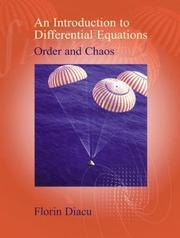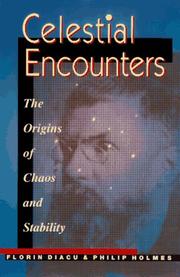| Listing 1 - 10 of 10 |
Sort by
|
Book
ISBN: 946239038X 9491216678 9786613946935 9491216686 1283634481 Year: 2012 Publisher: Amsterdam : Atlantis Press,
Abstract | Keywords | Export | Availability | Bookmark
 Loading...
Loading...Choose an application
- Reference Manager
- EndNote
- RefWorks (Direct export to RefWorks)
The guiding light of this monograph is a question easy to understand but difficult to answer: {What is the shape of the universe? In other words, how do we measure the shortest distance between two points of the physical space? Should we follow a straight line, as on a flat table, fly along a circle, as between Paris and New York, or take some other path, and if so, what would that path look like? If you accept that the model proposed here, which assumes a gravitational law extended to a universe of constant curvature, is a good approximation of the physical reality (and I will later outline a few arguments in this direction), then we can answer the above question for distances comparable to those of our solar system. More precisely, this monograph provides a mathematical proof that, for distances of the order of 10 AU, space is Euclidean. This result is, of course, not surprising for such small cosmic scales. Physicists take the flatness of space for granted in regions of that size. But it is good to finally have a mathematical confirmation in this sense. Our main goals, however, are mathematical. We will shed some light on the dynamics of N point masses that move in spaces of non-zero constant curvature according to an attraction law that naturally extends classical Newtonian gravitation beyond the flat (Euclidean) space. This extension is given by the cotangent potential, proposed by the German mathematician Ernest Schering in 1870. He was the first to obtain this analytic expression of a law suggested decades earlier for a 2-body problem in hyperbolic space by Janos Bolyai and, independently, by Nikolai Lobachevsky. As Newton's idea of gravitation was to introduce a force inversely proportional to the area of a sphere the same radius as the Euclidean distance between the bodies, Bolyai and Lobachevsky thought of a similar definition using the hyperbolic distance in hyperbolic space. The recent generalization we gave to the cotangent potential to any number N of bodies, led to the discovery of some interesting properties. This new research reveals certain connections among at least five branches of mathematics: classical dynamics, non-Euclidean geometry, geometric topology, Lie groups, and the theory of polytopes.
Celestial mechanics. --- Differentiable dynamical systems. --- Differential equations. --- Many-body problem -- Numerical solutions. --- Many-body problem --- Differential equations --- Celestial mechanics --- Mathematics --- Physical Sciences & Mathematics --- Calculus --- Numerical solutions --- Many-body problem. --- Equilibrium. --- Balance --- Balance (Physics) --- Balancing (Physics) --- n-body problem --- Problem of many bodies --- Problem of n-bodies --- Mathematics. --- Dynamics. --- Ergodic theory. --- Dynamical Systems and Ergodic Theory. --- Ordinary Differential Equations. --- Mathematics, general. --- Stability --- Statics --- Mechanics, Analytic --- Differential Equations. --- Math --- Science --- 517.91 Differential equations --- Differential dynamical systems --- Dynamical systems, Differentiable --- Dynamics, Differentiable --- Global analysis (Mathematics) --- Topological dynamics --- Ergodic transformations --- Continuous groups --- Mathematical physics --- Measure theory --- Transformations (Mathematics) --- Dynamical systems --- Kinetics --- Force and energy --- Mechanics --- Physics
Book
ISBN: 9780821891360 Year: 2014 Publisher: Providence American Mathematical Society
Abstract | Keywords | Export | Availability | Bookmark
 Loading...
Loading...Choose an application
- Reference Manager
- EndNote
- RefWorks (Direct export to RefWorks)
Many-body problem. --- Spaces of constant curvature. --- Celestial mechanics. --- Problème des N corps --- Espaces à courbure constante --- Mécanique céleste --- Numerical solutions of algebraic equations --- Celestial mechanics --- Many-body problem --- Spaces of constant curvature --- 51 <082.1> --- Constant curvature, Spaces of --- Curvature --- Geometry, Differential --- n-body problem --- Problem of many bodies --- Problem of n-bodies --- Mechanics, Analytic --- Gravitational astronomy --- Mechanics, Celestial --- Astrophysics --- Mechanics --- Mathematics--Series

ISBN: 0716732963 Year: 2000 Publisher: New York (N.Y.): Freeman
Abstract | Keywords | Export | Availability | Bookmark
 Loading...
Loading...Choose an application
- Reference Manager
- EndNote
- RefWorks (Direct export to RefWorks)
Digital
ISBN: 9789491216688 Year: 2012 Publisher: Paris Imprint: Atlantis Press
Abstract | Keywords | Export | Availability | Bookmark
 Loading...
Loading...Choose an application
- Reference Manager
- EndNote
- RefWorks (Direct export to RefWorks)
Ergodic theory. Information theory --- Differential equations --- Mathematics --- differentiaalvergelijkingen --- wiskunde --- informatietheorie
Book
ISBN: 9781400833443 Year: 2009 Publisher: Princeton, NJ
Abstract | Keywords | Export | Availability | Bookmark
 Loading...
Loading...Choose an application
- Reference Manager
- EndNote
- RefWorks (Direct export to RefWorks)

ISBN: 0691027439 9780691027432 0691005451 9780691005454 Year: 1996 Publisher: Princeton : Princeton University Press,
Abstract | Keywords | Export | Availability | Bookmark
 Loading...
Loading...Choose an application
- Reference Manager
- EndNote
- RefWorks (Direct export to RefWorks)
Celestial Encounters is for anyone who has ever wondered about the foundations of chaos. In 1888, the 34-year-old Henri Poincare submitted a paper that was to change the course of science, but not before it underwent significant changes itself. "The Three-Body Problem and the Equations of Dynamics" won a prize sponsored by King Oscar II of Sweden and Norway and the journal Acta Mathematica, but after accepting the prize, Poincare found a serious mistake in his work. While correcting it, he discovered the phenomenon of chaos. Starting with the story of Poincare's work, Florin Diacu and Philip Holmes trace the history of attempts to solve the problems of celestial mechanics first posed in Isaac Newton's Principia in 1686. In describing how mathematical rigor was brought to bear on one of our oldest fascinations--the motions of the heavens--they introduce the people whose ideas led to the flourishing field now called nonlinear dynamics. In presenting the modern theory of dynamical systems, the models underlying much of modern science are described pictorially, using the geometrical language invented by Poincare.
Mathematical statistics --- Many-body problem. --- Chaotic behavior in systems. --- Celestial mechanics --- Celestial mechanics. --- Hemelmechanica. --- Veel-deeltjes-systemen. --- Problème des N corps. --- Chaos (théorie des systèmes). --- Mécanique céleste. --- Problème à N-corps. --- Système dynamique. --- Chaos. --- Chaotic behavior in systems --- Many-body problem --- Many body problem
Book
ISBN: 0691221839 Year: 1996 Publisher: Princeton, New Jersey : Princeton University Press,
Abstract | Keywords | Export | Availability | Bookmark
 Loading...
Loading...Choose an application
- Reference Manager
- EndNote
- RefWorks (Direct export to RefWorks)
Celestial Encounters is for anyone who has ever wondered about the foundations of chaos. In 1888, the 34-year-old Henri Poincaré submitted a paper that was to change the course of science, but not before it underwent significant changes itself. "The Three-Body Problem and the Equations of Dynamics" won a prize sponsored by King Oscar II of Sweden and Norway and the journal Acta Mathematica, but after accepting the prize, Poincaré found a serious mistake in his work. While correcting it, he discovered the phenomenon of chaos. Starting with the story of Poincaré's work, Florin Diacu and Philip Holmes trace the history of attempts to solve the problems of celestial mechanics first posed in Isaac Newton's Principia in 1686. In describing how mathematical rigor was brought to bear on one of our oldest fascinations--the motions of the heavens--they introduce the people whose ideas led to the flourishing field now called nonlinear dynamics. In presenting the modern theory of dynamical systems, the models underlying much of modern science are described pictorially, using the geometrical language invented by Poincaré. More generally, the authors reflect on mathematical creativity and the roles that chance encounters, politics, and circumstance play in it.
Many-body problem. --- Chaotic behavior in systems. --- Celestial mechanics. --- Acceleration. --- Acta Mathematica. --- Alekseev, V. M. --- American Mathematical Society. --- Arnold diffusion. --- Asteroid. --- Benjamin Pierce lecturer. --- Bifurcation theory. --- Brown, Scott. --- Calculus of variations. --- Cantor set. --- Conservation law. --- Degrees of freedom. --- Dimension theory. --- Eccentricity. --- Ecology. --- Elasticity (theory). --- Ellipse. --- Fields Medal. --- First return map. --- Fixed point. --- Four-body problem. --- Function. --- Gerver, Joseph. --- Gravitation. --- Harvard University. --- Hirsch, Morris. --- Hopf bifurcation. --- Independent integrals. --- Isoperimetric property. --- Isosceles problem. --- Jones, Vaughan. --- KAM theory. --- Kovalevskaia top. --- Lagrangian solutions. --- Legion of Honor. --- Lewis Institute. --- Major axis. --- Manifold. --- Mendelian laws. --- Mercury. --- Momentum. --- Morrison Prize. --- New York University. --- Operator theory. --- Orbit. --- Panthéon. --- Pendulum. --- Physical space. --- Quantum mechanics. --- Saddle. --- Gravitational astronomy --- Mechanics, Celestial --- Astrophysics --- Mechanics --- Chaos in systems --- Chaos theory --- Chaotic motion in systems --- Differentiable dynamical systems --- Dynamics --- Nonlinear theories --- System theory --- n-body problem --- Problem of many bodies --- Problem of n-bodies --- Mechanics, Analytic
Book
Abstract | Keywords | Export | Availability | Bookmark
 Loading...
Loading...Choose an application
- Reference Manager
- EndNote
- RefWorks (Direct export to RefWorks)
Book
ISBN: 9789491216688 Year: 2012 Publisher: Paris Atlantis Press
Abstract | Keywords | Export | Availability | Bookmark
 Loading...
Loading...Choose an application
- Reference Manager
- EndNote
- RefWorks (Direct export to RefWorks)
The guiding light of this monograph is a question easy to understand but difficult to answer: {What is the shape of the universe? In other words, how do we measure the shortest distance between two points of the physical space? Should we follow a straight line, as on a flat table, fly along a circle, as between Paris and New York, or take some other path, and if so, what would that path look like? If you accept that the model proposed here, which assumes a gravitational law extended to a universe of constant curvature, is a good approximation of the physical reality (and I will later outline a few arguments in this direction), then we can answer the above question for distances comparable to those of our solar system. More precisely, this monograph provides a mathematical proof that, for distances of the order of 10 AU, space is Euclidean. This result is, of course, not surprising for such small cosmic scales. Physicists take the flatness of space for granted in regions of that size. But it is good to finally have a mathematical confirmation in this sense. Our main goals, however, are mathematical. We will shed some light on the dynamics of N point masses that move in spaces of non-zero constant curvature according to an attraction law that naturally extends classical Newtonian gravitation beyond the flat (Euclidean) space. This extension is given by the cotangent potential, proposed by the German mathematician Ernest Schering in 1870. He was the first to obtain this analytic expression of a law suggested decades earlier for a 2-body problem in hyperbolic space by Janos Bolyai and, independently, by Nikolai Lobachevsky. As Newton's idea of gravitation was to introduce a force inversely proportional to the area of a sphere the same radius as the Euclidean distance between the bodies, Bolyai and Lobachevsky thought of a similar definition using the hyperbolic distance in hyperbolic space. The recent generalization we gave to the cotangent potential to any number N of bodies, led to the discovery of some interesting properties. This new research reveals certain connections among at least five branches of mathematics: classical dynamics, non-Euclidean geometry, geometric topology, Lie groups, and the theory of polytopes.
Ergodic theory. Information theory --- Differential equations --- Mathematics --- differentiaalvergelijkingen --- wiskunde --- informatietheorie
Book

ISBN: 9780691222486 Year: 2022 Publisher: Princeton, NJ
Abstract | Keywords | Export | Availability | Bookmark
 Loading...
Loading...Choose an application
- Reference Manager
- EndNote
- RefWorks (Direct export to RefWorks)
| Listing 1 - 10 of 10 |
Sort by
|

 Search
Search Feedback
Feedback About UniCat
About UniCat  Help
Help News
News